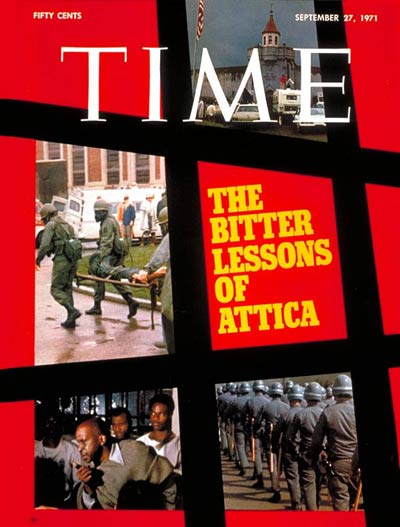
Even in the aftermath, it wasn’t immediately clear what had gone wrong at Attica Correctional Facility on Sept. 9, 1971. Was it the word that, the day before, an inmate been accosted for refusing to leave his cell? Or was it when reports spread that two inmates had been beaten in the aftermath of throwing a piece of glass at a guard? In any case, around 8:30 that morning, the New York State prison was the scene of an uprising that remains, 45 years later, one of the most famous and infamous events in the history of criminal justice in the United States.
For days, about half of the prisoners at Attica held control of one whole cell block, in addition to other parts of the facility, and about 40 hostages. After negotiations stalled and authorities violently retook the prison on Sept. 13, dozens of inmates and nine hostages were dead. Many more were injured.
“For some time to come in the U.S., that word will not be primarily identified with the plain upon which ancient Athens nurtured philosophy and democracy,” TIME noted two weeks later, in a cover story about the event. “Nor will it simply stand for the bucolic little town that gave its name to a turreted prison, mislabeled a ‘correctional facility.’ Attica will evoke the bloodiest prison rebellion in U.S. history. It will take its place alongside Kent State, Jackson State, My Lai and other traumatic events that have shaken the American conscience and incited searing controversy over the application of force—and the pressures that provoke it.”
Get your history fix in one place: sign up for the weekly TIME History newsletter
Here’s how TIME described the retaking of the prison:
At 9:32, a radio observer in a helicopter reported that hostages, guarded by six inmates, were confined within a circle of park benches in the yard. Sharpshooters were advised to take aim at the threatening convicts—”but you’ll have to have hostile action by the inmates to fire.” Then the two helicopters, loaded with tear-gas canisters, swept low over the prison, one of them barely clearing the walls. “To all posts,” barked the command radio. “Jackpot One is about to make drop.” There was a pause. “Jackpot has made drop. Base to all posts —move in; launch the offensive.”
The choking gas, which induces tears and nausea, filled the yard. At first the gunfire was barely audible over the roar of the choppers. From one helicopter, an amplified voice kept repeating: “Put your hands over your head. Walk to the outside of the yard. You will not be harmed. Do not harm the hostages.”
But as troopers dropped into the clouded compound, hostage blurred with prisoner. Some rescuers tried to reach the captive guards and pull them to safety. Others headed unresisting inmates toward the secure cell blocks. But there was an abundance of shooting. “We piled through and raced past Times Square,” recalled one police sergeant. “The ones that resisted—throwing spears and Molotov cocktails—were cut down. We caught some men with arms extended to throw weapons. Anybody that resisted was killed.” Claimed one officer: “They came at us like a banzai charge, waving knives and spears. Those we had to shoot.”
Yet much of the shooting may not have been all that necessary. A team of doctors who treated prisoners in their cells later said inmates in widely-separated parts of the prison described in identical detail instances of “indiscriminate” firing by the officers and the calculated slaying of unresisting convicts. Reported Dr. Lionel Sifontes of Buffalo: “Many of the ringleaders were approached by guards and shot systematically. Some had their hands in the air surrendering. Some were lying on the ground.”
That issue, the question that swept the nation in the aftermath of the riot, helped turn Attica into more than just an isolated moment of darkness. Had it been necessary? To some, the use of force had simply not come soon enough; to others, it was a symbol of the tragic inhumanity of the entire prison system. The riot exposed not merely the problems that affected the inmates at one particular prison, but also the fault lines that ran throughout American society.
Read the entire cover story, here in the TIME Vault: War at Attica
More Must-Reads from TIME
- Cybersecurity Experts Are Sounding the Alarm on DOGE
- Meet the 2025 Women of the Year
- The Harsh Truth About Disability Inclusion
- Why Do More Young Adults Have Cancer?
- Colman Domingo Leads With Radical Love
- How to Get Better at Doing Things Alone
- Michelle Zauner Stares Down the Darkness
Write to Lily Rothman at lily.rothman@time.com